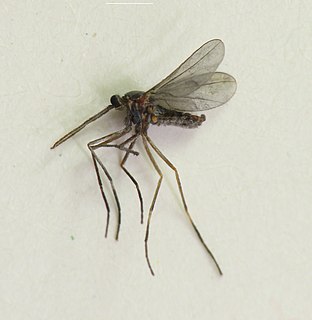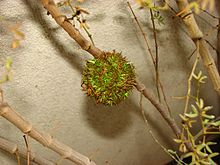
Larrea tridentata, called creosote bush and greasewood as a plant, chaparral as a medicinal herb, and gobernadora in Mexico, due to its ability to secure more water by inhibiting the growth of nearby plants. In Sonora, it is more commonly called hediondilla; Spanish hediondo = "smelly".

Galls or cecidia are a kind of swelling growth on the external tissues of plants, fungi, or animals. Plant galls are abnormal outgrowths of plant tissues, similar to benign tumors or warts in animals. They can be caused by various parasites, from viruses, fungi and bacteria, to other plants, insects and mites. Plant galls are often highly organized structures so that the cause of the gall can often be determined without the actual agent being identified. This applies particularly to some insect and mite plant galls. The study of plant galls is known as cecidology.

Cecidomyiidae is a family of flies known as gall midges or gall gnats. As the name implies, the larvae of most gall midges feed within plant tissue, creating abnormal plant growths called galls. Cecidomyiidae are very fragile small insects usually only 2–3 mm (0.079–0.118 in) in length; many are less than 1 mm (0.039 in) long. They are characterised by hairy wings, unusual in the order Diptera, and have long antennae. Some Cecidomyiids are also known for the strange phenomenon of paedogenesis in which the larval stage reproduces without maturing first. In some species, the daughter larvae consume the mother, while in others, reproduction occurs later on in the egg or pupa.
Orseolia oryzae, also called the Asian rice gall midge, is a species of small fly in the family Cecidomyiidae. It is a major insect pest of rice. The damage to the crop is done by the larvae which form galls commonly known as "silver shoots" or "onion shoots". The rice plant is stunted and the seed heads fail to develop.
Daphnephila truncicola is a species of gall midges first associated with stem galls on Lauraceae species, particularly Machilus thunbergii in Taiwan. Based on analysis on sequences of the mitochondrial cytochrome c oxidase subunit I, it has been suggested that in this genus, the stem-galling habit is a more ancestral state as opposed to the leaf-galling habit. This genus appears to have originated tropically and dispersed to Japan through Taiwan.
Daphnephila ornithocephala is a species of gall midge first associated with leaf galls on Lauraceae species, particularly Machilus thunbergii in Taiwan. Based on analysis on sequences of the mitochondrial cytochrome c oxidase subunit I, it has been suggested that in this genus, the stem-galling habit is a more ancestral state as opposed to the leaf-galling habit. This genus appears to have originated tropically and dispersed to Japan through Taiwan.
Daphnephila stenocalia is a species of gall midges first associated with leaf galls on Lauraceae species, particularly Machilus thunbergii in Taiwan. Based on analysis on sequences of the mitochondrial cytochrome c oxidase subunit I, it has been suggested that in this genus, the stem-galling habit is a more ancestral state as opposed to the leaf-galling habit. This genus appears to have originated tropically and dispersed to Japan through Taiwan.

A gnat is any of many species of tiny flying insects in the dipterid suborder Nematocera, especially those in the families Mycetophilidae, Anisopodidae and Sciaridae. They can be both biting and non-biting. Most often they fly in large numbers, called clouds. "Gnat" is a loose descriptive category rather than a phylogenetic or other technical term, so there is no scientific consensus on what constitutes a gnat. Some entomologists consider only non-biting flies to be gnats. Certain universities and institutes also distinguish eye gnats: the Smithsonian Institution describes them as "non-biting flies, no bigger than a few grains of salt, ... attracted to fluids secreted by your eyes".

Asphondylia is a cosmopolitan genus of gall midges in the family Cecidomyiidae. All species in this genus induce galls on plants, especially on flowers and flower buds. There are over 300 described species in Asphondylia, with many more likely to be discovered and described, especially in the southern hemisphere. Within the genus, characteristics of the larvae and pupae are often most useful for distinguishing between species since adults of most species look very similar to one another. The species inducing a given gall can sometimes be identified based on the shape and placement of the gall in combination with the identity of the host plant.

Asphondyliini is a tribe of gall midges in the family Cecidomyiidae. There are about six genera and at least 100 described species in Asphondyliini.

Rhopalomyia pomum, the sponge gall midge, is a species of gall midges, insects in the family Cecidomyiidae. The midges form leaf galls on Great Basin sagebrush.

Asphondylia helianthiglobulus is a species of gall midge in the family Cecidomyiidae. The larvae of this species induce galls on the stems of several sunflower species in eastern North America, including Helianthus giganteus,H. grosseserratus, and H. maximiliani.
Asphondylia auripila is a species of gall midges in the family Cecidomyiidae.

Rabdophaga rigidae, the willow beaked-gall midge, is a species of gall midge in the family Cecidomyiidae. It is found across North America. Some sources state that it is also present in parts of eastern Asia including Japan; however, a 2006 study shows that the Asian populations likely represent a separate species: Rabdophaga salicivora.
Asphondylia floccosa, the woolly stem gall midge, is a species of gall midges in the family Cecidomyiidae.
Asphondylia ceanothi, the ceanothus bud gall midge, is a species of gall midges in the family Cecidomyiidae.

Asphondylia solidaginis is a species of gall midge (Cecidomyiidae) that induces galls on goldenrods in North America where it is widespread. It was first described by William Beutenmuller in 1907.
Daphnephila is a genus of gall midge that appears in the Palearctic and Oriental biogeographic realms. Daphnephila species create leaf and stem galls on species of laurel plants, particularly in Machilus. Based on analysis on sequences of the mitochondrial cytochrome c oxidase subunit I, it has been suggested that in this genus, the stem-galling habit is a more ancestral state as opposed to the leaf-galling habit.
Asphondylia amaranthi is a species of gall midge in the family Cecidomyiidae.
Asphondylia antennariae is a species of gall midge in the family Cecidomyiidae. The larvae of this species induce galls on the buds of Antennaria plantaginifolia. This species is known from Wisconsin and Maine in the United States, though it's host plant is widespread in eastern North America. It was first described by American entomologist William Morton Wheeler in 1889.









